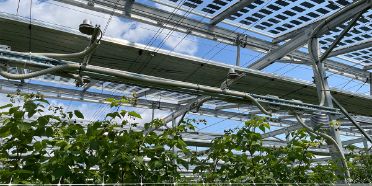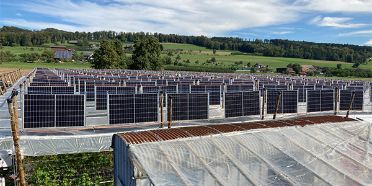Development and comparison of different agrivoltaic technologies on berry crops
The company Bioschmid gmbh protects its raspberries from heavy rainfall and heat with PV modules on three trial fields. The Laboratory for Photovoltaic Systems is in charge of the measurements on the PV system.
Factsheet
- Lead school School of Engineering and Computer Science
- Institute Institute for Energy and Mobility Research IEM
- Research unit IEM / Photovoltaic systems
- Funding organisation Schweizerische Eidgenossenschaft (Bundesverwaltung)
- Duration (planned) 01.09.2022 - 31.12.2025
- Project management Prof. Dr. Christof Bucher
- Head of project Matthias Hügi
-
Project staff
Sebastian Tobias Koch
Dr. Louis Sutter
Patrick Frauchiger
Andrea Seiberth
Heinz Schmid
David Ziegler -
Partner
Bundesamt für Energie BFE
bioschmid GmbH
Agroscope
Oberfeld Energie GmbH
Insolight SA
Megasol Energie AG - Keywords Agrivoltaics, agriphotovoltaics, agri-PV, electricity production, raspberry farming, decentralised power supply, plant-optimised operations, yield simulation
Situation
In order to achieve as soon as possible the targets for the use of photovoltaic systems associated with the energy transition, PV systems should also be built outside of the built environment. The combination of agriculture and electricity production on the same land (called agriphotovoltaics, agrivoltaics or “agri-PV”) holds great potential. Growing competition for land use can be avoided. The total yield from agricultural and electricity production should be greater than the sum of the two individual yields if they were to share the land side by side. In Switzerland, farming crops such as berries are particularly affected by the increased heatwaves, rainfalls, etc. caused by climate change and must therefore be grown under weather protection. However, these devices intensify temperatures and therefore need shading nets. Bioschmid’s agrivoltaic project aims to investigate the suitability of three different agrivoltaic systems in comparison to conventional raspberry farming. The goal is to demonstrate that PV systems are suitable as weather protection for farming and that shading with such systems can contribute to positive crop yields. Furthermore, the development of a cost-effective while at the same time efficient agrivoltaic system for a broad application in farming should be made possible.
Course of action
In order to find out how well the three systems work, the project will examine the generated electricity of the entire system, and equip selected solar modules in each of three sub-systems with optimisers. This will make it possible to perform analyses at module level. The development of the cultivated berries will be monitored and compared by Agroscope. The influence of the solar plant and of its shading will be examined, and data on pest infestation, crop yield, etc. collected. Data from the environment, the modules and the inverters collected throughout the project will be analysed and compared to evaluate the suitability of the three different subsystems. The resulting energy yields will be compared with values from simulations in order to verify the appropriateness of such simulation software. The analysis of the optimiser yield data is intended to show how great the added value of the optimisers is in an agrivoltaic system compared to a conventional inverter concept. The focus here is to investigate the inhomogeneity of the backside irradiance on the bifacial modules caused by farming.

